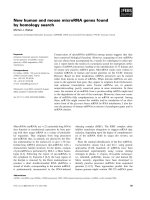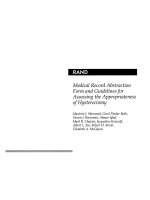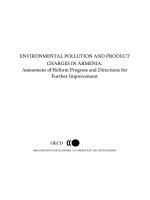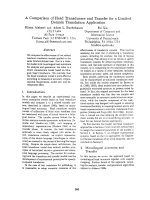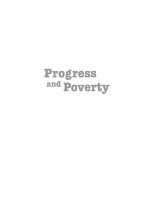Progress and Poverty - edited and abridged for modern readers by Bob Drake pptx
Bạn đang xem bản rút gọn của tài liệu. Xem và tải ngay bản đầy đủ của tài liệu tại đây (1.4 MB, 344 trang )
Progress
and
Poverty
Progress
and
Poverty
Why there are recessions
and poverty amid plenty
— and what to do about it!
Henry George
Edited and abridged
for modern readers by Bob Drake
Robert Schalkenbach Foundation
Henry George
Progress and Poverty
Why there are recessions, and poverty amid plenty
— and what to do about it!
Edited and abridged for modern readers by Bob Drake
Book and cover design by Lindy Davies
ISBN 0-911312-98-6
Library of Congress Control Number: 2006928337
First Edition
Copyright © 2006 by the Robert Schalkenbach Foundation
149 Madison Avenue, Suite 601
New York NY 10016
Contents
Publisher’s Foreword by Cliff Cobb IX
Editor’s Preface by Bob Drake XII
Author’s Preface to the Fourth Edition XV
Introduction: The Problem of Poverty Amid Progress 1
First Part: Wages and Capital
1. Why Traditional Theories of Wages are Wrong 8
2. Defining Terms 17
3. Wages Are Produced By Labor, Not Drawn From
Capital 28
4. Workers Not Supported By Capital 41
5. The True Functions of Capital 46
Second Part: Population and Subsistence
6. The Theory of Population According to Malthus 51
7. Malthus vs. Facts 57
8. Malthus vs. Analogies 69
9. Malthusian Theory Disproved 75
Third Part: The Laws of Distribution
10. Necessary Relation of the Laws of Distribution 83
11. The Law Of Rent 89
12. The Cause of Interest 95
13. False Interest 102
14. The Law Of Interest 106
15. The Law Of Wages 111
16. Correlating The Laws of Distribution 120
17. The Problem Explained 123
Fourth Part: The Effect of Material Progress
on the Distribution of Wealth
18. Dynamic Forces Not Yet Explored 126
19. Population Growth and Distribution of Wealth 128
20. Technology and the Distribution of Wealth 137
21. Speculation 142
Fifth Part: The Problem Solved
22. The Root Cause of Recessions 145
23. The Persistence of Poverty
Despite Increasing Wealth 155
Sixth Part: The Remedy
24. Ineffective Remedies 165
25. The True Remedy 180
Seventh Part: Justice of the Remedy
26. The Injustice of Private Property In Land 182
27. The Enslavement of Labor 192
28. Are Landowners Entitled to Compensation? 198
29. History of Land as Private Property 203
30. History of Property in Land in the US 211
Eighth Part: Application of the Remedy
31. Private Property in Land is Inconsistent
with the Best Use of Land 219
32. Securing Equal Rights To Land 223
33. The Canons of Taxation 226
34. Endorsements And Objections 236
Ninth Part: Effects of the Remedy
35. The Effect on Production 242
36. The Effect on The Distribution of Wealth 246
37. The Effect on Individuals and Classes 250
38. Changes in Society 254
Tenth Part: The Law of Human Progress
39. The Cause of Human Progress 263
40. Differences in Civilizations 270
41. The Law of Human Progress 275
42. How Modern Civilization May Decline 287
43. The Central Truth 295
44. Conclusion: The Individual Life 300
Afterword: Who Was Henry George?
by Agnes George de Mille 304
Index 311
Publisher’s Foreword IX
Publisher’s Foreword
WE OWE Bob Drake a debt of gratitude for this meticu-
lous condensation and modernization of Henry George’s
great work. The original version had an elegance that
evoked a passion for social justice among millions of read-
ers in the nineteenth and early twentieth centuries. How-
ever, by the beginning of the twenty-first century, George’s
complex prose stood in the way of that intention for large
numbers of people. Now his ideas can once again be widely
accessible.
What were those ideas and why are they still impor-
tant today? When Progress and Poverty was published in
1879, it was aimed in part at discrediting Social Darwin-
ism, the idea that “survival of the fittest” should serve as a
social philosophy. That ideology, developed by Herbert
Spencer, William Graham Sumner, and others, provided
the intellectual basis for 1) American imperialism against
Mexico and the Philippines, 2) tax policies designed to
reduce burdens on the rich by shifting them onto the poor
and middle class, 3) the ascendancy of the concept of ab-
solute property rights, unmitigated by any social claims
on property, 4) welfare programs that treat the poor as
failures and misfits, 5) racial segregation in education and
housing, and 6) eugenics programs to promote the “supe-
rior” race. The intellectual defense of racism is in abey-
ance, but the economic and political instruments of
domination have changed little. The renewed defense of
X Progress and Poverty
taxing wages and consumer goods rather than property
holdings, expanded intellectual property rights, and vast
imperial ambitions are indications that Social Darwinism
is back in full force.
The revival of Social Darwinism continues to justify
social disparities on the basis of natural superiority or
fitness. Progress and Poverty, by contrast, reveals that those
disparities derive from special privileges. Many econo-
mists and politicians foster the illusion that great for-
tunes and poverty stem from the presence or absence of
individual skill and risk-taking. Henry George, by con-
trast, showed that the wealth gap occurs because a few
people are allowed to monopolize natural opportunities
and deny them to others. If we deprived social elites of
those monopolies, the whole facade of their greater “fit-
ness” would come tumbling down. George did not advo-
cate equality of income, the forcible redistribution of
wealth, or government management of the economy. He
simply believed that in a society not burdened by the
demands of a privileged elite, a full and satisfying life
would be attainable by everyone.
Henry George is best remembered as an advocate of
the “single tax” on location values. (I say “location” rather
than “land” to avoid the common confusion that George
was primarily interested in rural land. In fact his attention
was focused on the tens of trillions of dollars worth of
urban land that derives its value from location.) Yet, for
George, wise tax policy was merely a vehicle to break the
stranglehold of speculative ownership that effectively limits
the opportunity to earn an decent living and participate in
public life.
Perhaps the image that best captures George’s ultimate
intention is the final scene in a popular science fiction
Publisher’s Foreword XI
film, when the hero is able to restore the oxygen supply
to the surface of a planet so that people will no longer be
enslaved by the man holding the oxygen monopoly. Free-
ing people from the oppression of monopoly power in
any form was Henry George’s great dream. Those who
have conceived of George as being concerned only with
tax policy should closely read the last third of Progress
and Poverty, which reveals his larger vision of justice and
genuine freedom.
Progress and Poverty stands the test of time. It con-
tains profound economic analysis, penetrating social phi-
losophy, and a practical guide to public policy. Those who
read it today will find in George’s work a great source of
vision and inspiration.
Cliff Cobb, Program Director
Robert Schalkenbach Foundation
XII Progress and Poverty
Editor’s Preface
THOSE WHO FIRST pick up this book are likely to share
some concern about the problem of poverty; those who
finish it may also find some cause for hope. For the great
gift that Henry George gave the world was a systematic
explanation—logical and consistent—of why wealth is not
distributed fairly among those who produce it. But he did
not stop there—he also gave us a simple yet far-reaching
plan for a cure. It was, and still is, a plan for peace, pros-
perity, equality, and justice.
Progress and Poverty is an enduring classic. It has been
translated into dozens of languages; millions of copies have
been distributed worldwide.
Why, then, the need for a modern edition, and an
abridged one at that? Simply put, Henry George, like
many late-19th century authors, wrote in a style that
modern readers may find unduly complex. As editor, I
have endeavored to break long and intricate sentences
into shorter ones, creating what I call a “thought-by-
thought translation.”
Furthermore, references to history, mythology, and lit-
erature that do not advance the central argument have been
removed. Gender-balanced language has also been incor-
porated. However, I have not attempted to update finan-
cial statistics or technological examples.
I prepared this edition in two distinct stages: modern-
ization and condensation. I have sought to ensure that
Editor’s Preface XIII
nothing of substance was left out.
In modernizing the text, I reduced the average sen-
tence length and increased the number of sentences. Sen-
tences were shortened by about one-third. For example,
one passage showed a decline in average sentence length
from twenty-eight words to nineteen words. By compari-
son, the average sentence in Time magazine was fifteen
words in 1974, perhaps fewer today.
By simplifying language, I reduced the number of syl-
lables per hundred words by about ten percent, to about
1.7 syllables per word. The number of sentences per hun-
dred words was increased by fifty percent.
The combined effect of these changes transformed the
text from one comprehensible to only a small fraction of
the population to one that can be easily read by a high-
school senior. An early test I performed showed that stu-
dents were able to read the modernized text about
twenty-five percent faster than the original, even before
condensation. Although no formal testing for comprehen-
sion was done, anecdotal reports indicate that comprehen-
sion was greatly improved.
In the second stage, I condensed the modernized text
by rewriting sentences using simpler language, removing
multiple examples where one would suffice, and generally
editing for brevity. Although I occasionally rearranged sen-
tences for clarity and continuity, keeping George’s origi-
nal thesis intact was of utmost importance. In doing this,
I followed the exposition as Henry George presented it. I
endeavored to remove what is excessive and retain what is
essential. In the end, this edition is less than half the size
of the original.
This project has been a collective endeavor. Many
people contributed to the various drafts, starting with those
XIV Progress and Poverty
teachers and students at the Henry George Schools in
Chicago, New York, and Philadelphia who provided sug-
gestions and encouragement.
Many thanks to Terry Topczewski, Bob Jene, the late
Roy Corr, and Chuck Metalitz for their help and encour-
agement at various stages; Wyn Achenbaum, Herb Barry,
Cliff Cobb, George Collins, Josh Farley, Damon Gross,
Heather Remoff, and Tom Smith of the Robert
Schalkenbach Foundation board for their editorial reviews;
and George M. Menninger, Jr., John Kuchta, Scott Walton,
Sue Walton, Bruce Oatman, and Steve Zarlenga for their
moral support. Particular thanks to Lindy Davies and Mark
Sullivan for their assistance in the final stages of editing
and text preparation. Thanks also to the Robert
Schalkenbach Foundation and the Center for the Study of
Economics for institutional support.
Finally, special thanks must go to my wife (and great
jazz singer) Spider Saloff. Without her love and support,
none of the rest would have mattered.
Bob Drake, President,
Henry George School of Chicago
April 15, 2006
Author’s Preface XV
Preface to the Fourth Edition
IN 1871, I FIRST PUBLISHED these ideas in a pamphlet en-
titled Our Land and Land Policy. Over time, I became
even more convinced of their truth. Seeing that many
misconceptions blocked their recognition, a fuller expla-
nation seemed necessary. Still, it was impossible to an-
swer all the questions as fully as they deserve. I have tried
to establish general principles, trusting readers to extend
their application.
While this book may be best appreciated by those fa-
miliar with economics, no previous study is needed to un-
derstand its argument or to judge its conclusions. I have
relied upon facts of common knowledge and common
observation, which readers can verify for themselves. They
can also decide whether the reasoning is valid.
I set out to discover why wages tend to a bare mini-
mum despite increasing productive power. The current
theory of wages, I found, is based on a misconception
[namely, that wages are paid from capital]. In truth, wages
are produced by the labor for which they are paid. There-
fore, other things being equal, wages should increase with
the number of laborers.
This immediately confronts the influential Malthu-
sian doctrine that population tends to increase faster than
subsistence. Examination shows that this theory has no
real support. When brought to a decisive test, it is utterly
disproved.
XVI Progress and Poverty
Since these theories cannot explain the connection
between progress and poverty, the solution must lie in the
three laws governing the distribution of wealth. These laws
should correlate with each other, yet economists fail to
show this. An examination of terminology reveals the con-
fusion of thought that permits this discrepancy.
To work out these laws, I first take up the law of rent.
Although economists correctly understand this law, they
fail to appreciate its implications. For whatever determines
the part of production that goes to landowners must nec-
essarily determine what is left over for labor and capital.
Nonetheless, I independently deduce the law of inter-
est and the law of wages. Investigation shows that interest
and wages rise together when rent falls, and fall together
when rent rises. Therefore, rent, wages, and interest are all
determined by the margin of production, the point in pro-
duction where rent begins. I also point out a source of
much confusion: mistaking the profits of monopoly for
the legitimate earnings of capital.
The laws of distribution are thus brought into har-
mony. The fact that rent always increases with material
progress explains why wages and interest do not.
The question is, what causes rent to increase? Popula-
tion growth not only lowers the margin of production, it
also increases productivity. Both factors increase the pro-
portion of income taken by rent, reducing the proportion
of wages and interest. Yet, technological and organizational
improvements lead to the same results. Even with a con-
stant population, these alone would produce all the effects
Malthus attributes to population growth—as long as land
is held as private property.
Further, progress inevitably causes a continuous, specu-
lative increase in land values if land is private property.
Author’s Preface XVII
This drives rent up and wages down. It also produces pe-
riodic industrial depressions.
This analysis points to a remedy, although a radical
one. But is there any other? Examining other measures
advocated to raise wages merely proves our conclusion.
Nothing short of making land common property can per-
manently relieve poverty.
The question of justice naturally arises, so I next ex-
amine the nature and basis of property. There is a funda-
mental and irreconcilable difference between property in
the products of labor and property in land. One has a natu-
ral basis, the other none. Recognizing property in land
inherently denies the right to property produced by labor.
Landowners have no claim to compensation if society
chooses to resume its natural rights. Private property in
land always has led—and always must lead—to the en-
slavement of workers as development proceeds. In the
United States, we are already beginning to feel the effects
of accepting this erroneous and destructive principle.
As a practical matter, private ownership of land is not
necessary for its use or improvement. In fact, it entails
enormous waste. Recognizing the common right to land
does not require any shock or dispossession. It can be
reached by the simple and easy method of taxing only land
values. The principles of taxation show that this is the best
means of raising revenue.
What would be the effects of this proposed change? It
would enormously increase production. It would secure
justice in distribution. It would benefit all classes. And it
would make possible a higher and nobler civilization.
The inquiry now rises to a wider field. My conclu-
sions assert certain laws. If these are really natural laws,
they must be apparent in universal history. As a final test,
XVIII Progress and Poverty
therefore, I must work out the law of human progress.
Investigation reveals that differences in civilization are
not due to differences in individuals or races, but rather to
differences in social organization. Progress is always
kindled by association. And civilization always declines as
inequality develops.
Even now, in modern civilization, the causes that have
destroyed all previous civilizations are beginning to ap-
pear. Political democracy, without economic opportunity,
will devolve into anarchy and despotism.
But the law of social life agrees with the great moral
law of justice. This shows how decline may be prevented
and a grander advance begun.
If I have correctly solved the great problems I set out
to investigate, my conclusions completely change the char-
acter of political economy. They give it the coherence and
certainty of a true science. And they bring it into sympa-
thy with the aspirations of humanity, from which it has
long been estranged.
What I have done in this book is to unite the truth
perceived by Smith and Ricardo with the truth perceived
by Proudhon and Lassalle.* I have shown that laissez
faire—in its full, true meaning—opens the way for us to
realize the noble dreams of socialism.
This work was written between August, 1877, and
March, 1879. Since its publication, events have shown these
views to be correct. The Irish land movement, especially,
shows the pressing nature of the problem.
* Adam Smith (1723-1790), David Ricardo (1772-1823), Pierre-
Joseph Proudhon (1809-1865), and Ferdinand Lassalle (1825-1864).
The first two were classical economists; the latter two were socialist
reformers.
Author’s Preface XIX
There has been nothing in the criticisms received to
induce me to change or modify these views. In fact, I have
yet to see an objection that was not already answered in
the book itself. Except for correcting some verbal errors
and adding this preface, this edition is the same as the
previous ones.*
Henry George
New York, November, 1880
Modernized and abridged, 2006
* George subsequently made one modification, regarding patents and
copyrights. See page 228.
XX Progress and Poverty
Author’s Preface XXI
To those who, seeing the vice
and misery that spring from the
unequal distribution of wealth
and privilege, feel the possi-
bility of a higher social state and
would strive for its attainment.
San Francisco, March, 1879
XXII Progress and Poverty
The Problem 1
Introduction
The Problem of Poverty Amid Progress
THE NINETEENTH CENTURY saw an enormous increase in
the ability to produce wealth. Steam and electricity, mecha-
nization, specialization, and new business methods greatly
increased the power of labor.
Who could have foreseen the steamship, the railroad,
the tractor? Or factories weaving cloth faster than hun-
dreds of weavers? Who could have heard the throb of
engines more powerful than all the beasts of burden com-
bined? Or envisioned the immense effort saved by im-
provements in transportation, communication, and
commerce?
Surely, these new powers would elevate society from
its foundations, lifting the poorest above worry for the
material needs of life. Imagine these new machines reliev-
ing human toil, muscles of iron making the poorest worker’s
life a holiday, giving our nobler impulses room to grow.
Given such bountiful material conditions, surely we could
anticipate the golden age long dreamed of. How could there
be greed when everyone had enough? How could things
that arise from poverty—crime, ignorance, brutality—ex-
ist when poverty had vanished? Such were the dreams born
of this wonderful century of progress.
True, there were disappointments. Discovery upon
discovery, invention after invention still did not lessen
2 Progress and Poverty
the toil of those who most need relief or bring plenty to
the poor. But it seemed there were so many things that
could be blamed for this failure that our faith has hardly
weakened. Surely we would overcome these difficulties
in time.
Yet we must now face facts we cannot mistake. All
over the world, we hear complaints of industrial depres-
sion: labor condemned to involuntary idleness; capital go-
ing to waste; fear and hardship haunting workers. All this
dull, deadening pain, this keen, maddening anguish, is
summed up in the familiar phrase “hard times.”
This situation can hardly be accounted for by local
causes. It is common to communities with widely differ-
ing circumstances, political institutions, financial systems,
population densities, and social organization. There is
economic distress under tyrannies, but also where power
is in the hands of the people. Distress where protective
tariffs hamper trade, but also where trade is nearly free.
Distress in countries with paper money, and in countries
with gold and silver currencies.
Beneath all this, we can infer a common cause. It is
either what we call material progress, or something closely
connected with it. What we call an industrial depression
is merely an intensification of phenomena that always ac-
company material progress. They show themselves more
clearly and more strongly as progress goes on.
Where do we find the deepest poverty, the hardest
struggle for existence, the greatest enforced idleness? Why,
wherever material progress is most advanced. That is to
say, where population is densest, wealth greatest, and pro-
duction and exchange most highly developed. In older
countries, destitution is found amid the greatest abundance.
The Problem 3
Conversely, workers emigrate to newer countries seek-
ing higher wages. Capital also flows there seeking higher
interest. They go where material progress is still in earlier
stages. The older countries, where material progress has
reached its later stages, is where poverty occurs.
Go to a new community where the race of progress is
just beginning, where production and exchange are still
rude and inefficient. The best house may be only a log
cabin; the richest person must work every day. There is
not enough wealth to enable any class to live in ease and
luxury. No one makes an easy living, or even a very good
one—yet everyone can make a living. While you won’t
find wealth and all its effects, neither will you find beg-
gars. No one willing and able to work lives in fear of want.
Though there is no luxury, there is no poverty.
But just when they start to achieve the conditions
civilized communities strive for, poverty takes a darker
turn. This occurs as savings in production and exchange
are made possible by denser settlement, closer connec-
tion with the rest of the world, and labor-saving ma-
chinery. It occurs just as wealth consequently increases.
(And wealth increases not only in the aggregate, but in
proportion to population.)
Now, some will find living better and easier—but oth-
ers will find it hard to get a living at all. Beggars and pris-
ons are the mark of progress as surely as elegant mansions,
bulging warehouses, and magnificent churches.
Unpleasant as it may be to admit, it is at last becoming
evident that progress has no tendency to reduce poverty.
The great fact is, poverty, with all its ills, appears when-
ever progress reaches a certain stage. Poverty is, in some
way, produced by progress itself.

